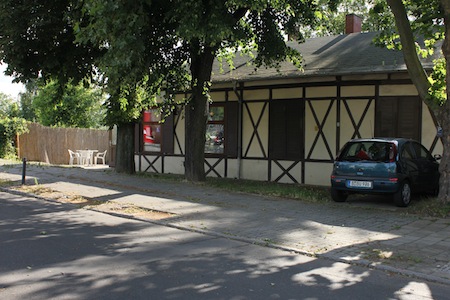
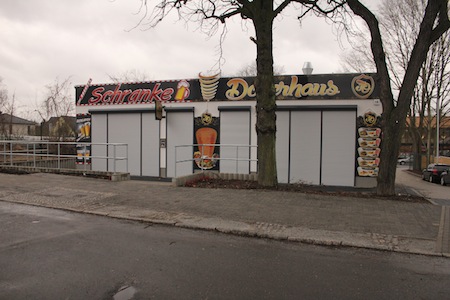
You might remember the randform post “Death of a pub” about the demolishment of a traditional Berlin pub/restaurant/dancehall. Meanwhile the restaurant got replaced by a building which provides room for two small facilities. One of the facilities, which hosts currently a little pub called “Schranke” (“barrier” or “level-crossing”) has a little beer terrace/garden next to the buidling. The other business sells Doner kebab and is called “Dönerhaus”. The former garden of the restaurant had been integrated into a parking lot. The images below and above display the new public space situation at the station. Judge yourself whether this is an improvement.
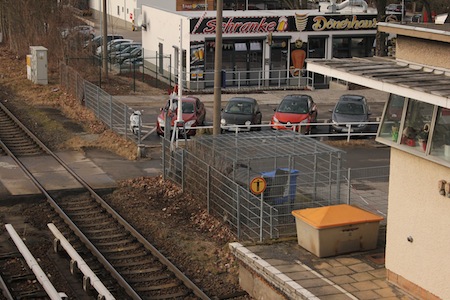
The new beergarden/terrace of the pub “Schranke”:
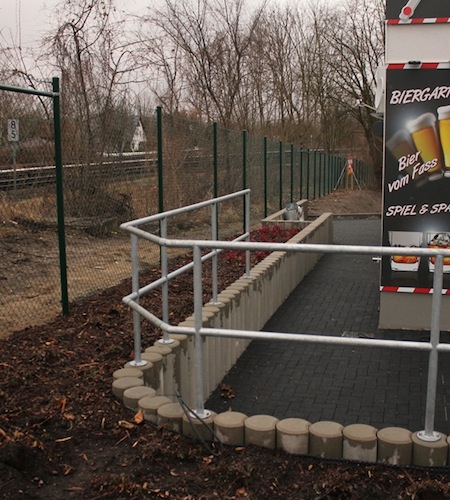
View onto the now vanished garden of the restaurant:
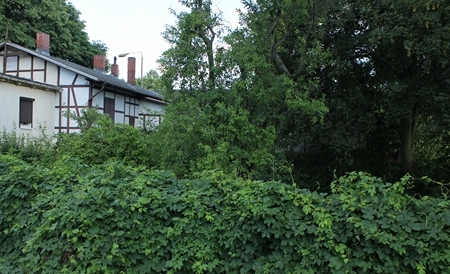
posted by nad
on Friday, February 24th, 2017 at 9:25 pm // Uncategorized.
// RSS 2.0 feed
skip to the end and leave a response // pinging is currently not allowed //
The below box is for leaving comments. Interesting comments in german, french and russian will eventually be translated into english. If you write a comment you consent to our data protection practices as specified
If your comment text is not too rude and if your URL is not clearly SPAM then both will be published after moderation. Your email adress will not be published. Moderation is done by hand and might take up to a couple of days.





March 3rd, 2017 at 2:16 pm
Are you angry about the “before and after” development?
if yes, with whom of the involved actors are you most angry with?
May 14th, 2017 at 8:14 am
How many dance/music locations are then now left in this neighbourhood?
May 14th, 2017 at 9:14 am
There is currently still the socalled TAP theatre:
http://www.tap-biesdorf.de/
It is the former training facility of the GDR army ensemble called “Erich Weinert”. After “Die Wende” the choir of the ensemble was about 2 years part of the Bundeswehr. After the financing period was over (1994) a private male choir formed and kept existing until 2005.
Since briefly after “Die Wende” the building has then been run by an NGO with very little funds. The NGO organized puppet theatres, senior dancing events etc. As far as I know the building belongs to the district and the lease of the NGO has been renewed on a yearly base, which left not much space for bigger investments. Currently the district tries to sell the building to “cultural entrepreneurs”, but as far as I know no “cultural entrepreneur” wants it (which was foreseeable). Since there are tons of car-sellers around the area of the theatre, I expect it will soon be sold, torn down and then turned into yet another car-seller.
There is a social neighbourhood centre in the vicinity : http://www.ball-ev-berlin.de/schloss_biesdorf.php run by an NGO for the unemployed and as you can see in the image there are medium sized rooms for little music performances, but it’s open only during the day. On the weekend it’s open only for special events. The NGO is currently also helping out with the nearby refugee home.
Then there is the Biesdorf Castle, which was recently renovated and as I described above costly rented out to a semi-private company. Apparently the castle is thought to be a “cultural centre”. I had recently a discussion with someone who often organizes Tango evenings (Milonga) in the centre of Berlin about wether to organize a Milonga there. So I called there and asked for the rental prices and it was WAY above what would be a realistic rental price for organizing such event. The rooms are actually even more expensive than in some hotels in Berlin City Centre.
Apriori, until its sold, a Milonga could probably still be organised in the TAP theatre, finally in Buenes Aires Milonga’s also often take place in rather uncosy Gyms etc. and the east german army architecture might even add some “socialist retro-chic”, but the Milonga organizer found that there are too many negative memories connected with this type of architecture for too many people living in the vicinity and if people pay for Milongas they do so only if the venue is half-way “romantic”.
So in short dance and music is to a great part finished in this neighbourhood.
For completeness I want to mention that there are also occasionally music concerts in the churches like theDorfkirche and a bit away in the Krankenhauskirche (Hospitalchurch).
May 14th, 2017 at 3:53 pm
It seems music and dance is not considered important in Germany. I guess you know that Germany performed very badly in the last ESC’s and it even doesn’t seem to be ashamed of that.
September 28th, 2017 at 9:08 pm
Well it seems I don’t get an answer. if I remember correctly you complained about the CDU politician Mr. Gräff and his opinion about the pub. I actually I asked someone to send me voting results in the federal elections in the vicinity of the pub and it was:
Wahllokal 414, Marzahn-Hellersdorf
1. CDU 28,9%
2. AfD 19,5%
3. Linke 19,3%
4. SPD 12,4%
5. FDP 7,7%
6. Grüne 7,7%
I.e. CDU won by a big margin. So I guess you maybe saw things a bit overly dramatic. In particular it seems people are highly approving CDU politcs there.
September 29th, 2017 at 8:09 am
Wahllokal 414 is in the vicinity, but in what I would call a very different area. The votes in Marzahn-Hellersdorf differ quite largely, depending on where exactly you are located.
THe Wahlkreis 414 belongs to the southern parts of Marzahn-Hellerdorf, to be exact the southern parts of the village Biesdorf. (“Dorf” means village). The north of Biesdorf is on a plateau and divided from the south by one of Berlins main thoroughfares. Wahlkreis 414 is an area with mostly new built one-family-homes. It is adjacent to the newly declared center of Biesdorf, the “Biesdorf Center”. The pub was in the north of Biesdorf. THere is a very nice interactive map by the newspaper Berliner Morgenpost, where you can compare. The Wahlkreis where the pub was located in, has the following (Zweitstimme) votes:
Wahllokal 413, Marzahn-Hellersdorf
1. Linke 24,5%
2. AfD 23,4%
3. CDU 23,1%
4. SPD 12,7%
5. FDP 5,2%
6. Grüne 5%
So there the right wing party AFD got even more votes than CDU.
I don’t think that the death of the pub was influencing peoples federal election votes very much in a concious way. That is usually you base such a vote on more important topics. But I could imagine that more or less unconciously people notice how their public spaces got diminished.
In that context I would also like to draw attention to the areas in the north-east belonging to the former village Hellersdorf, which are blue in the map. Blue means that the majority of votes went to the right wing party AFD. For example an area right next to a public green park-like setting along the brook “Wuhle” which is adjacent to the International Garden Exhibition and which hosts the U-Bahn Station for the exhibition got the following votes:
Wahllokal 308, Marzahn-Hellersdorf
1. AfD 30,2% 211 Stimmen
2. Linke 26,5% 185 Stimmen
3. CDU 14,9% 104 Stimmen
4. SPD 13,5% 94 Stimmen
5. FDP 4,7% 33 Stimmen
6. Grüne 3,2% 22 Stimmen
The U-Bahn Station was renamed for the occasion of the Garden Exhibition. Furthermore as I wrote here, for the exhibition a whole hill (“Kienberg”) was turned from a public recreational space into a part of the exhibition and there are sufficient rumors that it might not be returned. Marzahn-Hellerdorf is thought to be “densified” and it got in particular densified also with refugee homes. Here some images of that area.
You can tell that probably quite a bit of the votes were protest votes, like in the adjacent area the votes are:
Wahllokal 601, Marzahn-Hellersdorf
1. AfD 27,9%
2. Linke 22,2%
3. SPD 14,8%
4. CDU 13,7%
5. Die Partei 4,4%
6. Tierschutzpartei 4,2%
“Die Partei” is a satirical party and it got more votes than the green party. And “Tierschutzpartei” means “animal rights party”.